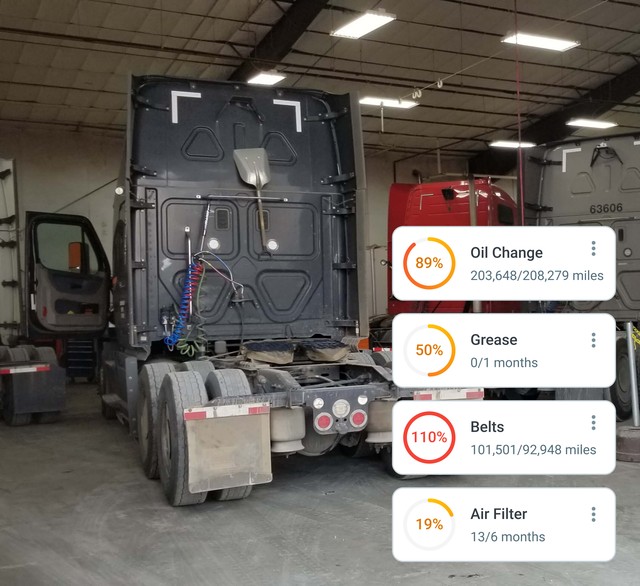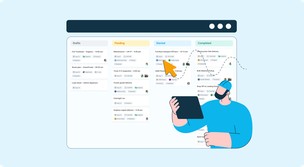Stop Fleet Breakdowns: The Smart Way to Schedule Maintenance Before Problems Hit
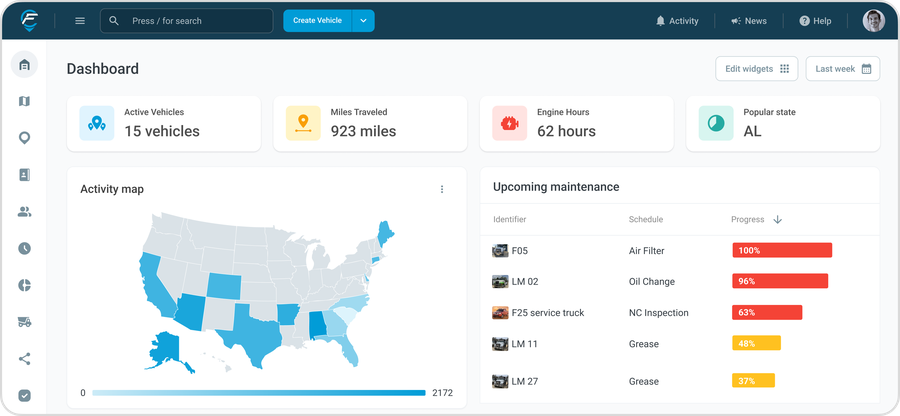
Picture this: It's 6 AM on a Tuesday, your biggest construction project is starting today, and your foreman just called. Three of your dump trucks won't start, your excavator is leaking hydraulic fluid all over the yard, and the job site crew is standing around waiting for equipment that should have been there an hour ago.
Sound familiar? If you're nodding your head, you're not alone. Last month, I spoke with a contractor in Phoenix who lost $12,000 in a single day because his fleet went down during peak season. "We had the work lined up," he told me, "but half our trucks were in the shop at once. Customers don't care about your maintenance problems—they just want their projects done."
Here's the thing most fleet managers learn the hard way: reactive maintenance doesn't just cost more money—it kills your reputation. But there's a better approach that forward-thinking construction companies are using to stay ahead of breakdowns, and it's simpler than you might think.
Why Most Fleet Maintenance Schedules Fail (And What Actually Works)
Let's be honest—most of us learned fleet maintenance from the school of "fix it when it breaks." Your dad probably told you to change the oil every 3,000 miles, rotate the tires twice a year, and pray nothing expensive goes wrong. That might work for your personal pickup truck, but it's a disaster waiting to happen when you're running 15 pieces of heavy equipment.
The problem with traditional maintenance scheduling is that it treats all vehicles the same. Your 2019 excavator that works 12-hour days in dusty conditions needs different care than your 2021 service truck that mostly drives highway miles between job sites. One-size-fits-all maintenance schedules are like wearing the same clothes in summer and winter—technically possible, but not very smart.
The Real Cost of Poor Maintenance Timing
Here's what happens when maintenance scheduling goes wrong:
- Cascade failures: One breakdown leads to three more as you overwork remaining equipment
- Emergency repair costs: Rush jobs cost 2-3x more than planned maintenance
- Lost productivity: Your crew gets paid whether equipment works or not
- Customer delays: Nothing damages relationships like missed deadlines
Smart maintenance scheduling isn't about following manufacturer recommendations blindly—it's about understanding your specific operation and planning around it.
Understanding Your Fleet's Maintenance Personality
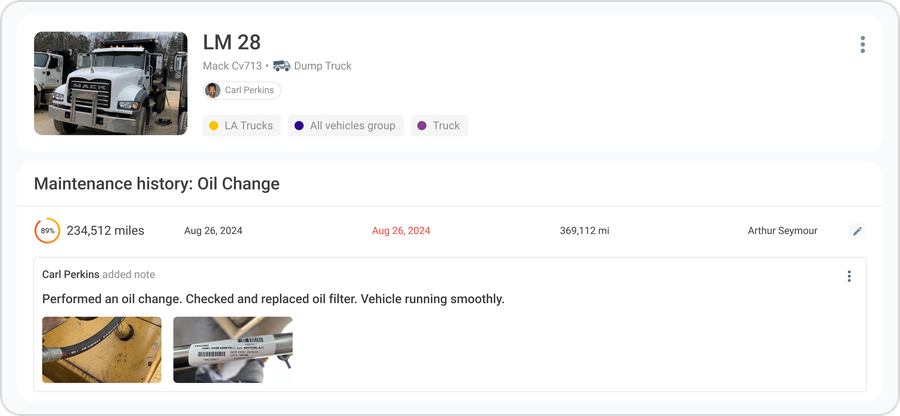
Every piece of equipment has its own "personality" when it comes to maintenance needs. Some machines are high-maintenance drama queens that need constant attention. Others are workhorses that run forever with basic care. The key is figuring out which is which before problems start.
Equipment Categories That Need Different Approaches
Heavy Use, Harsh Conditions (Excavators, Loaders, Dozers) These machines work in dirt, dust, and extreme conditions. They need maintenance 30-50% more frequently than manufacturer recommendations suggest. Think of them as the athletes of your fleet—they need extra care to perform at peak levels.
Medium Duty, Mixed Use (Dump Trucks, Utility Vehicles) Your bread-and-butter equipment that does a little bit of everything. Standard maintenance schedules usually work, but you need to watch for patterns based on the type of work they're doing most often.
Light Duty, Highway Miles (Service Trucks, Supervisory Vehicles) These can often go longer between services, but don't ignore them. A broken-down service truck might not stop production, but it can really mess up your day.
One contractor I know tracks his equipment like sports stats—hours worked, conditions faced, repairs needed. "My guys used to think I was crazy for writing everything down," he said, "but now we can predict problems weeks before they happen. We haven't had an unexpected breakdown in eight months."
Building a Maintenance Schedule That Actually Prevents Problems
The secret to effective maintenance scheduling isn't complicated software or expensive consultants—it's smart data collection and realistic planning. You need to know three things about every piece of equipment: how hard it works, what breaks most often, and when you can afford to take it offline.
Step 1: Know Your Equipment's Work Load
Track these key metrics for each machine:
- Operating hours per week
- Type of work performed
- Environmental conditions
- Load factors and stress levels
Step 2: Identify Your Maintenance Windows
Seasonal Planning Construction work has natural rhythms. Plan major services during slow periods, not when you're slammed with work. A smart contractor schedules transmission services in January, not June.
Project-Based Scheduling Coordinate maintenance with project timelines. Don't start a three-week job with equipment that's due for service halfway through.
Backup Equipment Strategy Always have a plan for when equipment goes down. Whether it's rental agreements, shared resources with other contractors, or strategic backup units.
Step 3: Create Realistic Service Intervals
Forget the manufacturer's schedule for a minute. Look at your actual data:
- How often do specific components actually fail?
- What repairs cost the most when they go wrong?
- Which maintenance tasks prevent the costliest failures?
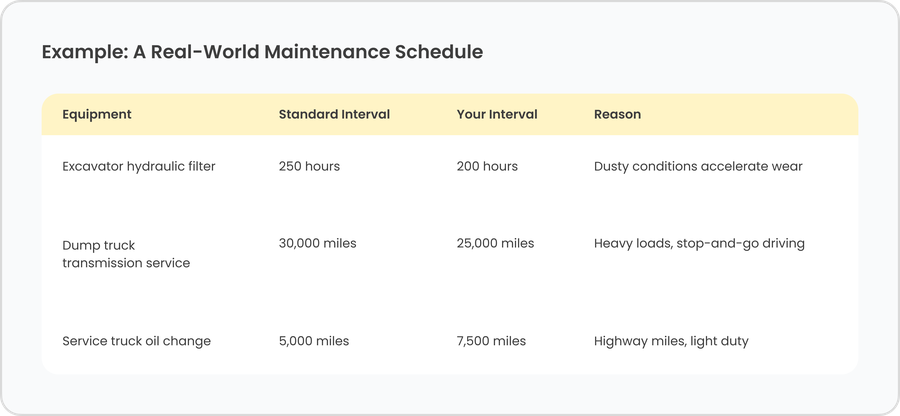
The Technology That Makes Maintenance Scheduling Actually Work
Here's where things get interesting. The best maintenance schedules aren't kept on clipboards or Excel spreadsheets—they're built into systems that track equipment automatically and remind you before problems start.
Modern fleet management platforms can monitor engine hours, track maintenance history, and even predict when components are likely to fail based on usage patterns. Fleet Chaser's maintenance module, for example, doesn't just remind you when service is due—it learns your equipment's patterns and adjusts schedules based on actual usage data.
What Good Maintenance Software Actually Does
Automatic Tracking No more guessing at operating hours or trying to remember when you last changed filters. The system knows exactly how hard each machine has been working.
Predictive Scheduling Instead of rigid time-based schedules, smart systems adjust maintenance timing based on actual usage, operating conditions, and historical data.
Parts and Vendor Management Good software helps you order parts before you need them and coordinates with your preferred service providers to minimize downtime.
"We went from spending half our Saturdays fixing broken equipment to actually having weekends free," one fleet manager told me. "The software doesn't just track maintenance—it prevents emergencies."
Common Maintenance Scheduling Mistakes (And How to Avoid Them)
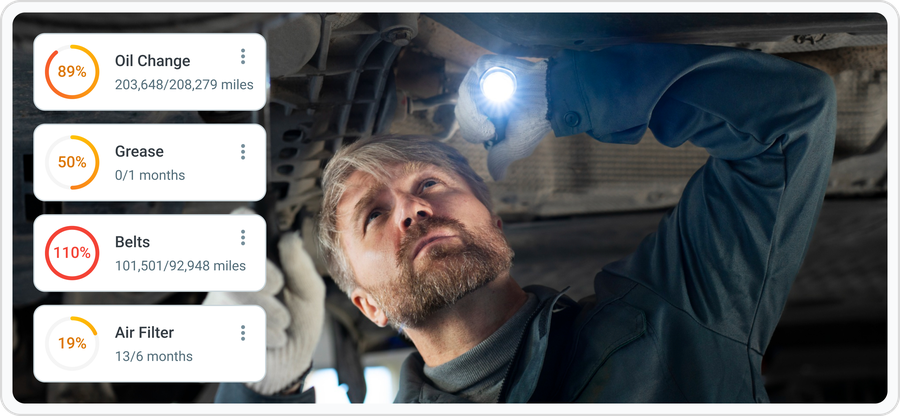
Even with the best intentions, maintenance scheduling can go wrong. Here are the mistakes I see most often, and what to do instead.
Mistake #1: Following Someone Else's Schedule
Your brother-in-law's concrete company might have a great maintenance routine, but their equipment, usage patterns, and operating conditions are different from yours. Build your schedule around your actual needs, not someone else's experience.
Mistake #2: Ignoring Seasonal Variations
Equipment works harder in some seasons than others. Your scheduling should reflect that reality. Air conditioning systems need more attention before summer, heating systems before winter. Adjust your maintenance calendar accordingly.
Mistake #3: Forgetting About Downtime Costs
A $500 maintenance service that prevents a $5,000 breakdown is always worth it, but only if you time it right. Don't save money on maintenance if it means losing money on missed deadlines.
Mistake #4: Not Training Your Team
The best maintenance schedule in the world won't work if your operators don't know how to spot early warning signs or your mechanics don't understand the priority system. Make sure everyone knows their role in keeping equipment running.
Making Your Maintenance Schedule Work in the Real World
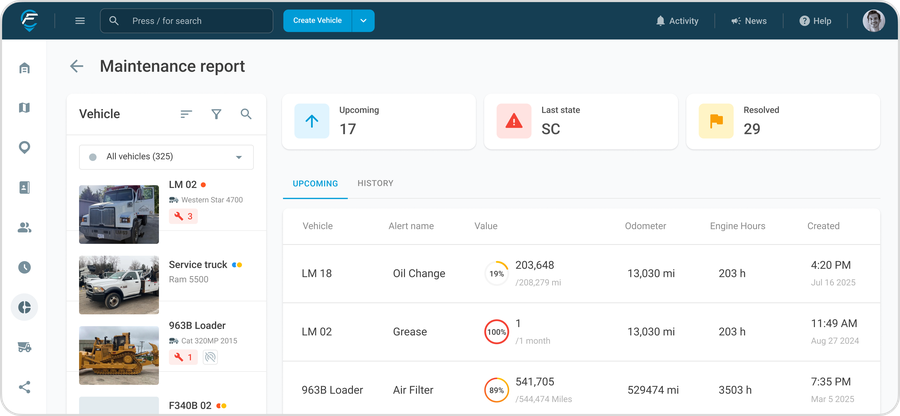
Theory is great, but execution is everything. The difference between a maintenance schedule that works and one that collects dust in a filing cabinet comes down to a few key practices.
Start Small and Build Up
Don't try to revolutionize everything at once. Pick your three most critical pieces of equipment and get their maintenance schedules dialed in perfectly. Then expand from there.
Make Someone Responsible
Maintenance scheduling can't be "everyone's job" because that means it's nobody's job. Assign one person to own the schedule and hold them accountable for results.
Track Your Results
Keep records of what works and what doesn't. Did that early oil change prevent the engine problem? Did waiting too long cost you three days of downtime? Use that information to improve your scheduling over time.
Fleet Chaser users report an average 35% reduction in unplanned maintenance costs within the first year of implementation. That's not just because the software is smart—it's because it makes good maintenance practices automatic instead of optional.
Key Takeaways: Building a Maintenance Schedule That Actually Works
- Know your equipment's work personality - High-stress machines need more frequent care than highway cruisers
- Plan around your business rhythm - Schedule major services during slow periods, not peak season
- Use real data, not generic recommendations - Your operating conditions determine your maintenance needs
- Make someone accountable - Maintenance scheduling needs an owner, not a committee
- Start simple and scale up - Perfect three machines before trying to optimize your entire fleet
- Track results and adjust - Good maintenance schedules evolve based on actual performance
Ready to stop playing maintenance roulette with your fleet? Fleet Chaser's predictive maintenance system takes the guesswork out of scheduling by tracking your equipment's actual usage patterns and alerting you before problems become emergencies.
See how Fleet Chaser's smart maintenance scheduling can prevent your next breakdown →
Don't wait for the 6 AM phone call about broken equipment. Start building a maintenance schedule that works for your operation, not against it.

















